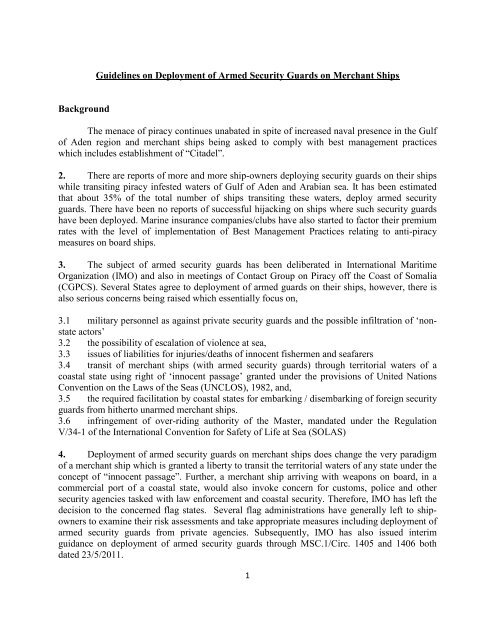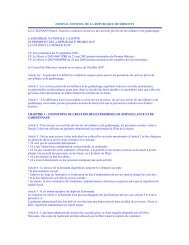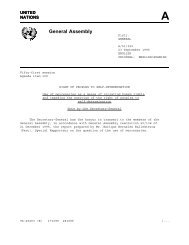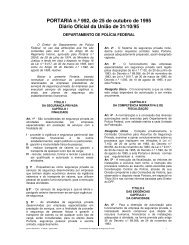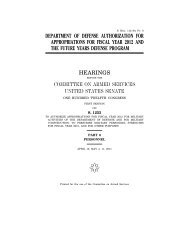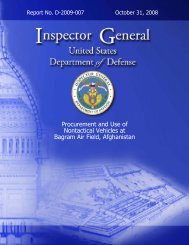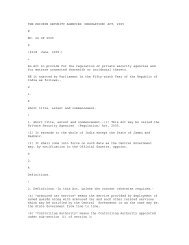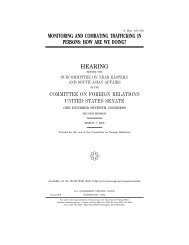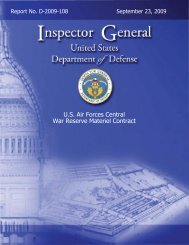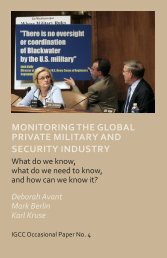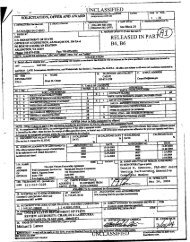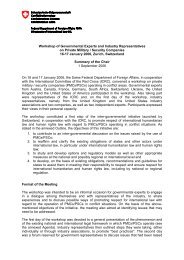Guidelines on Deployment of Armed Security Guards on Merchant ...
Guidelines on Deployment of Armed Security Guards on Merchant ...
Guidelines on Deployment of Armed Security Guards on Merchant ...
Create successful ePaper yourself
Turn your PDF publications into a flip-book with our unique Google optimized e-Paper software.
<str<strong>on</strong>g>Guidelines</str<strong>on</strong>g> <strong>on</strong> <strong>Deployment</strong> <strong>of</strong> <strong>Armed</strong> <strong>Security</strong> <strong>Guards</strong> <strong>on</strong> <strong>Merchant</strong> ShipsBackgroundThe menace <strong>of</strong> piracy c<strong>on</strong>tinues unabated in spite <strong>of</strong> increased naval presence in the Gulf<strong>of</strong> Aden regi<strong>on</strong> and merchant ships being asked to comply with best management practiceswhich includes establishment <strong>of</strong> “Citadel”.2. There are reports <strong>of</strong> more and more ship-owners deploying security guards <strong>on</strong> their shipswhile transiting piracy infested waters <strong>of</strong> Gulf <strong>of</strong> Aden and Arabian sea. It has been estimatedthat about 35% <strong>of</strong> the total number <strong>of</strong> ships transiting these waters, deploy armed securityguards. There have been no reports <strong>of</strong> successful hijacking <strong>on</strong> ships where such security guardshave been deployed. Marine insurance companies/clubs have also started to factor their premiumrates with the level <strong>of</strong> implementati<strong>on</strong> <strong>of</strong> Best Management Practices relating to anti-piracymeasures <strong>on</strong> board ships.3. The subject <strong>of</strong> armed security guards has been deliberated in Internati<strong>on</strong>al MaritimeOrganizati<strong>on</strong> (IMO) and also in meetings <strong>of</strong> C<strong>on</strong>tact Group <strong>on</strong> Piracy <strong>of</strong>f the Coast <strong>of</strong> Somalia(CGPCS). Several States agree to deployment <strong>of</strong> armed guards <strong>on</strong> their ships, however, there isalso serious c<strong>on</strong>cerns being raised which essentially focus <strong>on</strong>,3.1 military pers<strong>on</strong>nel as against private security guards and the possible infiltrati<strong>on</strong> <strong>of</strong> ‘n<strong>on</strong>stateactors’3.2 the possibility <strong>of</strong> escalati<strong>on</strong> <strong>of</strong> violence at sea,3.3 issues <strong>of</strong> liabilities for injuries/deaths <strong>of</strong> innocent fishermen and seafarers3.4 transit <strong>of</strong> merchant ships (with armed security guards) through territorial waters <strong>of</strong> acoastal state using right <strong>of</strong> ‘innocent passage’ granted under the provisi<strong>on</strong>s <strong>of</strong> United Nati<strong>on</strong>sC<strong>on</strong>venti<strong>on</strong> <strong>on</strong> the Laws <strong>of</strong> the Seas (UNCLOS), 1982, and,3.5 the required facilitati<strong>on</strong> by coastal states for embarking / disembarking <strong>of</strong> foreign securityguards from hitherto unarmed merchant ships.3.6 infringement <strong>of</strong> over-riding authority <strong>of</strong> the Master, mandated under the Regulati<strong>on</strong>V/34-1 <strong>of</strong> the Internati<strong>on</strong>al C<strong>on</strong>venti<strong>on</strong> for Safety <strong>of</strong> Life at Sea (SOLAS)4. <strong>Deployment</strong> <strong>of</strong> armed security guards <strong>on</strong> merchant ships does change the very paradigm<strong>of</strong> a merchant ship which is granted a liberty to transit the territorial waters <strong>of</strong> any state under thec<strong>on</strong>cept <strong>of</strong> “innocent passage”. Further, a merchant ship arriving with weap<strong>on</strong>s <strong>on</strong> board, in acommercial port <strong>of</strong> a coastal state, would also invoke c<strong>on</strong>cern for customs, police and othersecurity agencies tasked with law enforcement and coastal security. Therefore, IMO has left thedecisi<strong>on</strong> to the c<strong>on</strong>cerned flag states. Several flag administrati<strong>on</strong>s have generally left to shipownersto examine their risk assessments and take appropriate measures including deployment <strong>of</strong>armed security guards from private agencies. Subsequently, IMO has also issued interimguidance <strong>on</strong> deployment <strong>of</strong> armed security guards through MSC.1/Circ. 1405 and 1406 bothdated 23/5/2011.1
5. The subject has been deliberated at length in the Ministry <strong>of</strong> Shipping and it is noted thatdecisi<strong>on</strong> to employ armed security guards is complex <strong>on</strong>e and whilst not endorsing the use <strong>of</strong>armed guards <strong>on</strong> merchant ships, given the present serious danger to shipping from the pirates,the Indian ship owners may deploy armed security guards, subject to their risk assessmentparticularly for ships which bear slow speed and have low freeboard, and in pursuance <strong>of</strong> secti<strong>on</strong>86 “Transit and transshipment <strong>of</strong> stores” 77-“Declarati<strong>on</strong> by owner <strong>of</strong> baggage” and 80-Temporary Detenti<strong>on</strong> <strong>of</strong> Baggage <strong>of</strong> Customs Act 1962 and secti<strong>on</strong> 45 A <strong>of</strong> the Indian Arms Act1959. The following guidelines are issued in this regard:6 Criteria for engaging Private Maritime <strong>Security</strong> Company (PMSC)6.1 GeneralIt is imperative that while c<strong>on</strong>sidering c<strong>on</strong>tracting a PMSC to deploy their security guards<strong>on</strong> board Indian ships, due diligence is undertaken <strong>on</strong> following issues which are investigatedand enquired up<strong>on</strong>;.1 Company structure and place <strong>of</strong> registrati<strong>on</strong>;.2 Company ownership;.3 Financial positi<strong>on</strong> (e.g. annual accounts / bank references);.4 Extent <strong>of</strong> insurance cover (in particular covering third-party risks);.5 Senior management experience; and.6 Quality management indicators – e.g. Internati<strong>on</strong>al Organisati<strong>on</strong> for Standardizati<strong>on</strong>(ISO) accreditati<strong>on</strong>.6.2 PMSC Background informati<strong>on</strong>The PMSC should be able to provide documentary evidence which may include;.1 maritime (as opposed to land-based) experiences..2 written procedures <strong>on</strong> management including team-leading skills, chain <strong>of</strong> authority,change in command, resp<strong>on</strong>sibilities in life saving;.3 understanding <strong>of</strong> flag State, port state and coastal State requirements with respect tocarriage and usage <strong>of</strong> firearms;.4 availability <strong>of</strong> written testim<strong>on</strong>ials/references from previous clients in the maritimeindustry;.5 availability <strong>of</strong> documentary evidence that firearms are procured, transported, embarkedand disembarked legally;.6 understanding <strong>of</strong> the Somalia-based piracy threat including the military operati<strong>on</strong>s in thearea, and the means to maintain current knowledge;.7 understanding <strong>of</strong> anti-piracy measures as outlined in notices issued by DG Shipping andthe industry Best Management Practices for ship protecti<strong>on</strong> measures..8 access to legal advices (e.g. in-house counsel / external legal advisors) <strong>on</strong> a 24 x 7 basis.2
6.3 Selecti<strong>on</strong> and vetting <strong>of</strong> PMSCThe PMSC should be able to provide documentary evidence which may include;.1 criminal background checks;.2 history <strong>of</strong> employment checks;.3 military and law enforcement background checks, where applicable;.4 records <strong>of</strong> medical, physical, and mental fitness <strong>of</strong> pers<strong>on</strong>nel (including drug and alcoholtesting).5 verifiable system in place to ensure c<strong>on</strong>tinued suitability for employment <strong>of</strong> theirpers<strong>on</strong>nel.6 documentary evidence <strong>of</strong> relevant experience and certificati<strong>on</strong> in the use and carriage <strong>of</strong>firearms to be deployed; and.7 system for provisi<strong>on</strong> <strong>of</strong> security identity documentati<strong>on</strong>, travel documents and visas.6.4 Training <strong>of</strong> Privately C<strong>on</strong>tracted <strong>Armed</strong> <strong>Security</strong> Pers<strong>on</strong>nel (PCASP)Given the very peculiar nature <strong>of</strong> duties by armed security guards <strong>on</strong> board merchantships trading in internati<strong>on</strong>al waters, it is essential that ship owners should verify that PMSChave adequate training procedures in place. Therefore, PMSC should be able to providedocumentary evidence which may include;.1 comprehensive and detailed records <strong>of</strong> training, both initial and refresher training,available for inspecti<strong>on</strong>;.2 subject to any additi<strong>on</strong>al requirements <strong>of</strong> the flag State, armed security guards shouldhave received, as a minimum, ship-board familiarizati<strong>on</strong> training;.3 pers<strong>on</strong>nel trained and qualified to documented company standards in the appropriate use<strong>of</strong> force recognized principles/guidelines recognized by the flag state;.4 pers<strong>on</strong>nel trained to operate the specific firearms and other security equipment that willbe used <strong>on</strong> the vessels <strong>on</strong> which they will be deployed;.5 pers<strong>on</strong>nel given medical training to a recognized internati<strong>on</strong>al standard; and.6 pers<strong>on</strong>nel given appropriate training and/or briefing with specific references to the vesseltype, where that vessel will be trading, and the provisi<strong>on</strong>s <strong>of</strong> the Internati<strong>on</strong>al Ship and PortFacility <strong>Security</strong> (ISPS) Code, and the industry Best Management Practices for anti-piracymeasures.6.5 Service provisi<strong>on</strong> c<strong>on</strong>siderati<strong>on</strong>sOwners should verify that PMSC maintain insurance cover for themselves, theirpers<strong>on</strong>nel and third-party liability cover and that the PMSC terms <strong>of</strong> engagement do notprejudice or potentially prejudice the shipowners’ insurance cover.3
6.5.1 Shipowners insurance coverLiabilities, losses and expenses arising out <strong>of</strong> deployment <strong>of</strong> Private armed security guards mayimpact the shipowners insurance cover. Therefore it is str<strong>on</strong>gly recommended that shipownersc<strong>on</strong>sult their insurers prior to deploying private armed security guards <strong>on</strong> their ships.6.5.2 PMSC insurance coverPMSC should provide evidence that they hold and will c<strong>on</strong>tinue to hold valid insurance cover:.1 public and employers liability insurance cover to an appropriate level and as required bythe shipowner; and.2 pers<strong>on</strong>al accident, medical expenses, hospitalizati<strong>on</strong> and repatriati<strong>on</strong> insurance.The PMSC should insure its pers<strong>on</strong>nel to carry and use firearm <strong>on</strong> the high seas and territorialwaters, for accident, injury and damage arising from the use <strong>of</strong> firearms and liability for anyclaim that might arise from the carriage and use <strong>of</strong> firearms.6.6 <strong>Armed</strong> <strong>Security</strong> <strong>Guards</strong> team size, compositi<strong>on</strong> and equipmentThough ideal team size would be 5 pers<strong>on</strong>s, the compositi<strong>on</strong> could include 4 securityguards and <strong>on</strong>e team leader and <strong>on</strong>e <strong>of</strong> the team members as certified team medic (medicalpers<strong>on</strong>nel). The following factors should be discussed between the PMSC and the shipowner..1 Size <strong>of</strong> the security team- This would depend up<strong>on</strong> issues such as estimated time <strong>of</strong> thevessel transit, latest threat assessment, whether duties also include keeping additi<strong>on</strong>al look outduties and assisting the ship’s crew in rigging/unrigging ship protecti<strong>on</strong> measures and the sizeand the <strong>of</strong> the vessel..2 Ship safety certificate – The number <strong>of</strong> pers<strong>on</strong>s (including the team <strong>of</strong> security guards)<strong>on</strong> board the vessel is not to exceed, anytime, the maximum number for which the vessel iscertified as per her Safety Certificate..3 Equipment – This would be as per the requirements discussed between the shipownerand PMSC and commensurate with the risk assessment.6.7 Command and c<strong>on</strong>trol <strong>of</strong> <strong>on</strong>board security team:6.7.1 Shipowner when entering into c<strong>on</strong>tract with the PMSC, should ensure that command andc<strong>on</strong>trol structure with the Master/ship’s <strong>of</strong>ficers and the armed security guards team is clearlydefined and documented. In order to provide clarity, the documented command and c<strong>on</strong>trolstructures should provide inter-alia;4
.1 A clear statement that at all times the Master remains in command and retains theoverriding authority <strong>on</strong> board;.2 A clearly documented set <strong>of</strong> vessel and voyage-specific governance procedures, iter alia,covering procedure in the following paragraphs which include procedures for c<strong>on</strong>ductingexercise based <strong>on</strong> these procedures;.3 A documented list <strong>of</strong> duties, expected c<strong>on</strong>duct, behavior and documentati<strong>on</strong> <strong>of</strong> acti<strong>on</strong>s <strong>of</strong>armed security guards <strong>on</strong> board;.4 Transparent two-way informati<strong>on</strong> flow and recognizable coordinati<strong>on</strong> and cooperati<strong>on</strong>between the shipowner, charterer, team <strong>of</strong> security guards <strong>on</strong> board, PMSC and vessel’s Master,<strong>of</strong>ficers and crew.6.7.2 Factors to determine such success may include:.1 Providing regular updated intelligence-based threat assessments throughout thec<strong>on</strong>tracted period <strong>on</strong> board, and utilizing this informati<strong>on</strong> to <strong>of</strong>fer suggesti<strong>on</strong>s as to the vessel’sproposed routeing, amending same if required, and under the ship’s c<strong>on</strong>tractual arrangements;.2 M<strong>on</strong>itoring the daily activities <strong>of</strong> the <strong>on</strong>board team <strong>of</strong> security guards;.3 Having a 24-hour Emergency Resp<strong>on</strong>se and a C<strong>on</strong>tingency Plan in place covering allpotential acti<strong>on</strong>s; and.4 Providing feedback <strong>on</strong> crew training and ship hardening requirements based up<strong>on</strong> reportsreceived from the security guards team <strong>on</strong> board the ship..5 Providing for effective m<strong>on</strong>itoring and shore based support for <strong>on</strong> board security guardteam. Shore based support should also need to develop liais<strong>on</strong> through United KingdomMaritime Trade Operati<strong>on</strong>s (UKMTO) and Maritime <strong>Security</strong> Centre Horn <strong>of</strong> Africa(MSCHOA)..6 On board, the ship’s crew would need to be trained al<strong>on</strong>g with the security pers<strong>on</strong>nel toundertake counter piracy measures. This would be necessary so that command and c<strong>on</strong>trol duringan actual live operati<strong>on</strong>al situati<strong>on</strong> where security guards may have to open fire to ward <strong>of</strong>f thepirates, are clearly understood and practiced, keeping in view the unquesti<strong>on</strong>able legal authoritythe Master <strong>of</strong> the vessel over his ships and its crew including the security guards.6.8 Management <strong>of</strong> Firearms and Ammuniti<strong>on</strong>s from Embarkati<strong>on</strong> to Disembarkati<strong>on</strong>It is essential that armed security guard team <strong>on</strong>board is able to dem<strong>on</strong>strate resp<strong>on</strong>siblemanagement and use <strong>of</strong> weap<strong>on</strong>s and ammuniti<strong>on</strong> at all times when <strong>on</strong> board.The following issues should be included while c<strong>on</strong>ducting verificati<strong>on</strong> audit <strong>of</strong> PMSC:.1 Documented compliance with nati<strong>on</strong>al, coastal and port state legislati<strong>on</strong> and relati<strong>on</strong>shipgoverning the transport and provisi<strong>on</strong> <strong>of</strong> firearms, ammuniti<strong>on</strong> and security equipment to thepoint <strong>of</strong> embarkati<strong>on</strong> and disembarkati<strong>on</strong> or ports/places at which the vessel may call as part <strong>of</strong>its intended voyage whilst the armed security guard team is <strong>on</strong> board. The <strong>on</strong> board team shouldbe able to prove that actual inventory carried matches all documented declarati<strong>on</strong>s;.2 Appropriate c<strong>on</strong>tainers for firearms, ammuniti<strong>on</strong> and security equipment at the point <strong>of</strong>transfer to the ship;5
.3 Documented standards and procedures for a complete inventory <strong>of</strong> all firearms,ammuniti<strong>on</strong> and security equipment available up<strong>on</strong> arrival aboard the vessel (inventory shoulddetail the make, model, caliber and serial number <strong>of</strong> all firearms; and details <strong>of</strong> ammuniti<strong>on</strong> andamount).4 C<strong>on</strong>trol procedures for separate and secure <strong>on</strong>board stowage in a ‘str<strong>on</strong>g room’ anddeployment <strong>of</strong> firearms, ammuniti<strong>on</strong> and security equipment as per Annexure A enclosed;.5 Areas where firearms may or may not be carried, together with the weap<strong>on</strong> state (e.g.unloaded & magazine <strong>of</strong>f, magazine <strong>on</strong> and safety catch <strong>on</strong> and no round chambered) and whatwill initiate a change in that state should be c<strong>on</strong>firmed;.6 Detailed and exercised orders for when firearms can be loaded and ‘made ready’ for useshould be c<strong>on</strong>firmed, trained and documented during certain periods as listed in the PMSCc<strong>on</strong>tract, to ensure the highest <strong>of</strong> safety and operati<strong>on</strong>al capabilities for use <strong>of</strong> arms aboard thevessel; and.7 The inventory should be rec<strong>on</strong>ciled <strong>on</strong> disembarkati<strong>on</strong> <strong>of</strong> all arms and ammuniti<strong>on</strong> fromthe vessel.6.9 Rules for use <strong>of</strong> forceIt is essential that armed security guards team <strong>on</strong> board have a complete understanding <strong>of</strong> therules for the use <strong>of</strong> force as agreed between shipowner, PMSC and the Master and fully complywith them. The <strong>on</strong> board armed guard team should be fully aware that their primary functi<strong>on</strong> isthe preventi<strong>on</strong> <strong>of</strong> boarding using the minimal force necessary to do so. The PMSC shouldprovide a detailed graduated resp<strong>on</strong>se plan to a pirate attack as part <strong>of</strong> its teams’ operati<strong>on</strong>alprocedures.PMSC should require their pers<strong>on</strong>nel to take all resp<strong>on</strong>sible steps to avoid the use <strong>of</strong> force. Ifforce is used, it should be in a manner c<strong>on</strong>sistent with applicable law. In no case should the use<strong>of</strong> force exceed what is strictly necessary, and in all cases should be proporti<strong>on</strong>ate to the severity<strong>of</strong> threat and actual situati<strong>on</strong> at hand at the material point <strong>of</strong> time.PMSC should require that their pers<strong>on</strong>nel not use firearms against pers<strong>on</strong>s except in self defenceor defence <strong>of</strong> others against the imminent threat <strong>of</strong> death or serious injury, or to prevent thepreparati<strong>on</strong> <strong>of</strong> a particularly serious crime involving grave threat to life.6.10 Reporting and Record keepingThe Master should maintain a log <strong>of</strong> every circumstances in which firearms are discharged,whether accidental or deliberate. Such acti<strong>on</strong>s should be fully documented in sufficient detail inorder to produce a formal written record <strong>of</strong> the incident.In the event, it becomes necessary to use force by the armed security guard team, the team leadershould be advised to photograph(if appropriate), log, report and collate written statements fromall pers<strong>on</strong>s present at the incident in anticipati<strong>on</strong> <strong>of</strong> legal proceedings.6
In additi<strong>on</strong> to incident reporting, it is suggested that following a tour <strong>of</strong> duty, the <strong>on</strong>board teamshould submit a full report to the shipowner and the flag administrati<strong>on</strong>, giving full details <strong>of</strong> thedeployment, operati<strong>on</strong>al matters, any training and /or ship hardening c<strong>on</strong>ducted, and <strong>of</strong>feringadvice as to any other enhancements to security that may be c<strong>on</strong>sidered.6.11 A PMSC al<strong>on</strong>g with the shipowner should make arrangements with coastal state toembark & disembark security guards with their weap<strong>on</strong>s. Suitable permissi<strong>on</strong> from coastal statemay be obtained by c<strong>on</strong>cerned ship-owners for their ships to call at foreign ports and fortransiting through their coastal waters while such armed guards are <strong>on</strong>board their ships.7 Transit <strong>of</strong> armed merchant ships through Indian Exclusive Ec<strong>on</strong>omic Z<strong>on</strong>e (EEZ)7.1 While several navies c<strong>on</strong>centrate <strong>on</strong> protecting the trade route through Gulf <strong>of</strong> Aden,pirates have changed their tactics by using hijacked ships as ‘mother ships’, away from Gulf <strong>of</strong>Aden resulting into the ‘map’ <strong>of</strong> piracy incidents cluttering the expanse <strong>of</strong> Arabian sea. This hasresulted in ships charting their course more closer to the Indian coast line, as against taking amore direct route across the Arabian sea and hence account for -quantum jump <strong>on</strong> shippingtraffic in the India EEZ and even within Indian territorial waters. Substantial increase in number<strong>of</strong> ships transiting through Indian EEZ/territorial waters and proliferati<strong>on</strong> <strong>of</strong> private securityagency <strong>of</strong>fering services <strong>of</strong> security guards (use <strong>of</strong> n<strong>on</strong>-state actors in the guise <strong>of</strong> securityguards), particularly in view <strong>of</strong> the fact that deployment <strong>of</strong> armed guards <strong>on</strong> board, appears to bethe <strong>on</strong>ly effective deterrent, c<strong>on</strong>sequently increases the security c<strong>on</strong>cern for India.1976.Indian EEZ and the territorial waters are regulated through Maritime Z<strong>on</strong>es Act <strong>of</strong> India,7.2 C<strong>on</strong>sidering that the right <strong>of</strong> ‘innocent passage’ to merchant ships can not be summarilywithdrawn, it is imperative that measures are initiated to ensure due notificati<strong>on</strong> about carriage <strong>of</strong>weap<strong>on</strong>s/ammuniti<strong>on</strong> or armed security guards is received from all ships within Indian EEZ andIndian Search and Rescue Regi<strong>on</strong> (ISRR).Therefore it is essential that following informati<strong>on</strong> is provided in this c<strong>on</strong>text;7.3 All Indian vessels when visiting Indian ports shall provide the following informati<strong>on</strong> tothe jurisdicti<strong>on</strong>al port authority, customs and regi<strong>on</strong>al coast guard authority and Indian Navy, 96hours prior to their arrival, with their Pre Arrival Notificati<strong>on</strong> for <strong>Security</strong> (PANS);.1 Names, addresses and details <strong>of</strong> identificati<strong>on</strong> cards and passports <strong>of</strong> the securitypers<strong>on</strong>nel..2 Number and details (Make, Model, bore, caliber, serial number etc.) <strong>of</strong> firearms andammuniti<strong>on</strong>..3 Details <strong>of</strong> license issued or accepted by the jurisdicti<strong>on</strong>al nati<strong>on</strong>al administrati<strong>on</strong> wherethe PMSC is registered.7
7.4 All Indian vessels, when visiting foreign ports / waters shall be required to complywith the c<strong>on</strong>cerned regulati<strong>on</strong>s/requirements <strong>of</strong> the coastal states c<strong>on</strong>cerned.7.5 Foreign merchant vessels visiting Indian ports with armed security guards:.1 All armed security guards are required to be in possessi<strong>on</strong> <strong>of</strong> valid arms licenses issuedby the flag administrati<strong>on</strong> <strong>of</strong> the vessel..2 Where a private security company has been engaged by a ship owner to provide armedguards, such a private security company shall be in possessi<strong>on</strong> <strong>of</strong> a valid license issued by theflag administrati<strong>on</strong> <strong>of</strong> the country..3 All foreign vessels visiting Indian ports are required to secure their firearms andammuniti<strong>on</strong> in a guarded/secured ‘str<strong>on</strong>g room’ when entering Indian territorial waters..4 All foreign vessels are required to follow the reporting and declarati<strong>on</strong> requirements asstipulated under para 7.3.7.6 <strong>Merchant</strong> vessels transiting Indian waters with armed security guards7.6.1 All merchant vessels transiting through Indian EEZ and carrying armed guards arerequired to provide the informati<strong>on</strong> c<strong>on</strong>tained under para 7.3 to the Coast Guard and IndianNavy.7.7 Facilitati<strong>on</strong> to allow embarking / disembarking <strong>of</strong> armed security guards in Indianports<strong>Armed</strong> security guards when embarking or disembarking at any Indian port, would berequired to provide informati<strong>on</strong> c<strong>on</strong>tained in paras 7.3.1 to 7.3.3 herein before to thejurisdicti<strong>on</strong>al immigrati<strong>on</strong> and custom authorities and fully comply with the all other applicablecustoms and other regulatory / statutory requirements.These guidelines are subject to modificati<strong>on</strong>s by DG(Shipping) as and when feltnecessary.Issued vide F.No. SR-13020/6/2009-MG(pt.) dated 29/8/2011 Ministry <strong>of</strong> Shipping8
Annexure-A(Para 6.8)(a)(b)(c)(d)(e)(f)(g)(h)(i)(j)The str<strong>on</strong>g room should have metallic bulkheads and there should not be anyporthole/window.The str<strong>on</strong>g room should have a secure door.Str<strong>on</strong>g room door must have inbuilt lock with an additi<strong>on</strong>al arrangement for a padlock.The stowage racks for the small arms must have a chain securing arrangement.All keys must be numbered an in duplicate and in duplicate. An access c<strong>on</strong>trol log for thekeys and the str<strong>on</strong>g room must be maintained. The list <strong>of</strong> pers<strong>on</strong>nel authorized accessmust be cleared by the master <strong>of</strong> the vessel in additi<strong>on</strong> to the company.A log <strong>of</strong> entry or arms and the pers<strong>on</strong>nel authorized to do so, must be maintained.If feasible the ammuniti<strong>on</strong> must be stowed in a separate compartment/separate lockedarrangements.No other stores should be kept in the str<strong>on</strong>g room.The temperature in respect <strong>of</strong> fixed small arms ammuniti<strong>on</strong> must be below 49 degCelsius. Towards this a temperature measuring arrangement and regular inspecti<strong>on</strong>procedure should be instituted.No naked electric wire/cable to pass through the str<strong>on</strong>g room. If unavoidable suitableinsulati<strong>on</strong> to the provided. Switches for all electric point to be located outside the str<strong>on</strong>groom. All bulbs to be sheathed/ covered.The above recommendati<strong>on</strong>s may however be supplemented by otherprecauti<strong>on</strong>s/additi<strong>on</strong>al safety measures as dictated by the particular circumstances <strong>of</strong> a case or asdeemed appropriate by the shipowners/master.9


